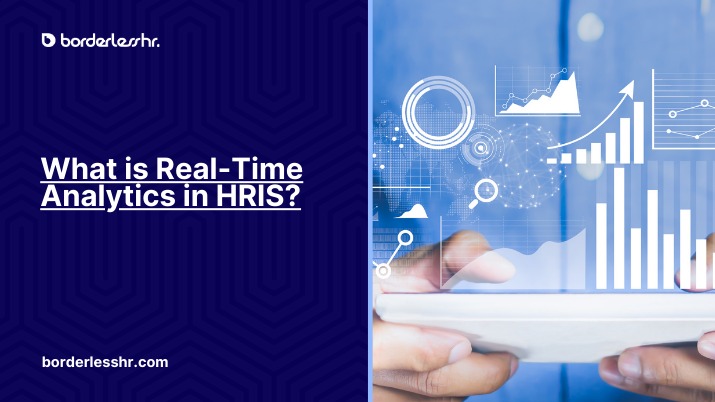In today’s fast-moving world, businesses are always looking for ways to stay ahead. One area where things have changed is in how companies manage their employees, thanks to what we call Human Resource Information Systems (HRIS).
Real-time analytics in HRIS is a new way of using technology to quickly understand what’s happening with employees. In this article, we’ll explain what real-time analytics in HRIS is, why it matters, and how it’s changing the way businesses handle their employees.
What is Real-Time Analytics in HRIS?
Real-time analytics in HRIS refers to the utilization of sophisticated tools and technologies to instantly gather, process, and analyze data pertaining to various aspects of workforce management. Unlike traditional HR systems that relied on static reports generated periodically, real-time analytics provides instantaneous insights into the current state of affairs within an organization’s workforce. This includes data related to recruitment, employee performance, engagement levels, retention rates, and more, empowering HR professionals with timely information to make informed decisions.
Key Parts of Real-Time Analytics in HRIS
- Bringing Data Together: Real-time analytics in HRIS needs to gather information from lots of different places, like databases, time trackers, payroll systems, and feedback from employees. All this information gets put together so HR people can use it to understand what’s happening with their workforce in real time.
- Fancy Tools for Understanding: Modern HRIS systems have tools that are really good at looking at all this information quickly. These tools use things like artificial intelligence and machine learning to understand what the data is saying. They can spot patterns, trends, and anomalies in the data that might not be obvious to humans.
- Easy-to-Read Dashboards: Instead of boring reports, HR people now get to look at colorful charts and graphs. These pictures make it easier to see what’s going on with employees, like who’s doing well and who might need some help. With intuitive dashboards, HR professionals can quickly identify areas that need attention and take action accordingly.
- Machine Learning and AI: Advancements in machine learning and artificial intelligence (AI) have revolutionized the capabilities of HRIS in analyzing and interpreting HR data. Machine learning algorithms can identify hidden patterns and insights within large datasets, automate routine HR tasks, and provide personalized recommendations for talent development and career progression.
Benefits of Real-Time Analytics in HRIS
- Making Better Choices: Having information right away means HR can make decisions faster. They can react to things like needing to hire more people or noticing when someone isn’t doing well. By making informed decisions in real time, HR can address issues promptly and keep the business running smoothly.
- Planning Smarter: By looking at what’s happening right now, HR can plan for the future better. They can figure out how to find the right people for the job and keep them happy. With insights from real-time analytics, HR can forecast staffing needs, anticipate skill gaps, and develop strategies to attract and retain top talent.
- Being Quick to Solve Problems: In a fast-changing world, it’s important to be able to fix problems fast. Real-time analytics helps HR spot problems early and fix them before they get worse. Whether it’s addressing performance issues, resolving conflicts, or improving employee engagement, real-time insights enable HR to respond swiftly and effectively.
- Giving Employees What They Need: With real-time analytics, HR can understand what each employee wants and needs. This means they can offer things like training or help with careers that are tailored to each person. By personalizing the employee experience, HR can boost engagement, satisfaction, and productivity across the organization.
- Saving Money: By using data to make better decisions, companies can save money. They can make sure they have enough staff without hiring too many people, and they can make sure everyone is happy and doing well at work. Real-time analytics help organizations optimize resources, reduce turnover costs, and improve operational efficiency, leading to significant cost savings over time.
Challenges and Things to Think About
Even though real-time analytics in HRIS is great, there are some things to watch out for:
- Making Sure Data is Good: It’s important that the information HR uses is accurate and safe. They need to make sure they’re not using wrong or old data, and they need to protect employees’ privacy. Establishing data quality standards and implementing robust security measures are essential to ensure the integrity and confidentiality of HR data.
- Getting Technology to Work Together: Sometimes it takes work to make different systems talk to each other. HR needs to make sure all the tools they use can work together smoothly. Integrating disparate HR systems and ensuring interoperability can be challenging, requiring careful planning and coordination between IT and HR departments.
- Helping People Adapt: Some people might need to be used to using data to make decisions. HR has to help everyone understand why real-time analytics is important and how to use it. Providing training and support to employees and stakeholders is crucial to fostering a data-driven culture and promoting the adoption of real-time analytics initiatives.
- Learning New Skills: Using real-time analytics means HR people need to learn new skills, like understanding data and using new software. Upskilling HR professionals and investing in continuous learning initiatives are essential to build data literacy and proficiency in leveraging real-time analytics tools effectively.
Conclusion
Real-time analytics in HRIS is a big deal for how companies manage their people. It gives them new ways to understand their employees and make decisions that help the business. Even though it can be tricky to get started with, the benefits are huge. By using real-time analytics, companies can be faster, smarter, and more in tune with what their employees need.
With real-time analytics, businesses can make decisions faster and plan for the future better. They can also make sure employees are happy and engaged, which is important for success. While there may be some challenges along the way, like learning new skills and making sure data is accurate, the rewards of using real-time analytics are worth it. It’s not just about using fancy technology – it’s about making HR smarter and helping businesses succeed in today’s fast-paced world. As companies continue to adapt to changes in the workforce, real-time analytics in HRIS will play a crucial role in shaping the future of HR management and organizational success.







